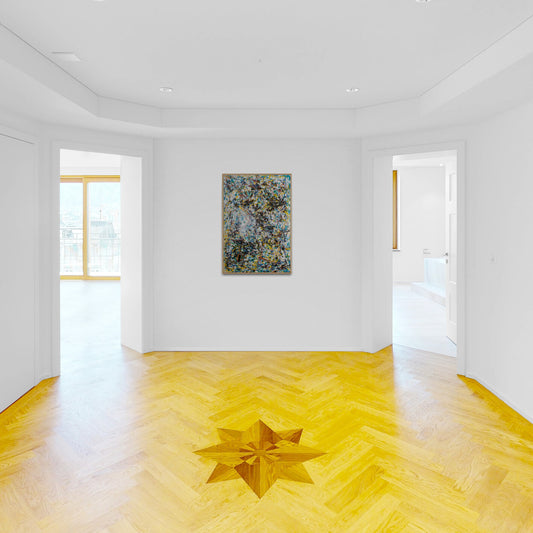
ITALY, 1922 - 2015
Angelino Balistreri
Was born on March 21, 1922 in Sardinia. Balistreri received art lessons in his childhood and his skills did not go unnoticed by his teacher. Because of this, he was able to work on church paintings as a painter and restorer in his youth. Angelino Balistreri continued his artistic training and was awarded the Premio Andaldo in 1936 for his work. After the outbreak of World War II, he volunteered for the British Army's Special Air Service in 1941. After the end of World War II, Balistreri resumed his work as a painter. He deals with landscapes, flowers, people and religious subjects. This was followed by years of artistic development, where he found much inspiration in Venice and in the Scuola Romana in Rome. In 1960 his depression took him from Italy to southern France. During this time he made many trips to North Africa, the Middle East and Madagascar. At that time of his life, he neglected painting. After his return to Italy in 1970, Balistreri made contact with the Roman gallery Astrolabio, which led to a fruitful collaboration. Exoticism and religious symbols gained importance in his work. Another artistic development was the intensive coloring of his works. As he grew older, he also turned to sculpture. Balistreri continued to work well into old age. He died in Macerata hospital in 2015.
Collapsible content
curriculum vitae and events
1922 - 1935
Angelino Balistreri, born on March 21, 1922 in Quartu Sant'Elena, Sardinia, showed his talent in art early on. Under the guidance of his teacher Giovanni Battista Scano, he specialized in details of religious works in Cagliari churches.
1936 - 1946
In the 1930s, Angelino Balistreri lived temporarily in Genoa, where he deepened his artistic training and won the Premio Ansaldo in 1936. After returning to Cagliari in 1938, he became involved in the anti-fascist resistance. During World War II he served in the British Special Air Service, fought in the Balkans and Italy and supported partisans. After the war in Corridonia, he married Delia Spalletti.
1947 - 1961
After the death of his first child in infancy and the birth of his son Mario Libero in 1948, Angelino Balistreri left Corridonia and moved with his family to Carbonia, Sardinia, where he painted primarily landscapes. However, isolation in Sardinia led him to return to Corridonia in the early 1950s. There and in cities such as Rome and Venice he established relationships with the art scene, found interest in the Scuola Romana and the CoBrA group and planned an exhibition with Antonio Ligabue that was never realized. Despite several exhibitions and recognition as a landscape painter, a personal and artistic crisis led Balistreri to leave Italy in the early 1960s and move to southern France.
1962 - 1971
Balistreri spent about a decade in cities like Marseille and Grenoble, making contacts in the art scene. His travels to Africa and the Middle East influenced his art, which became evident upon his return in the 1970s.
1972 - 1986
In Italy, Balistreri made contacts with the Astrolabio gallery in Rome and had successful exhibitions there for a decade. His works, characterized by exotic and religious symbolism, were well received. A painting caught the attention of the Pontifical Commission, and in the 1980s the artist Ewa Blaszak inspired him as a model.
1987 - 2011
After frequent absences, Balistreri divorced and left the Roman art scene. In Corridonia he established himself with an exhibition concept that showed his entire stylistic development. In the 80s and 90s he was influenced by the vibrant colors of his young models, resulting in striking colorism in his paintings as well as new sculptural works. Balistreri was well received at exhibitions in Europe, the USA and Japan. Later in his life he returned to his Sardinian roots and his family.
2012 - 2015
On his 90th birthday, the artist was awarded honorary citizenship of Corridonia. He also received the Order of Merit of the Italian Republic - the highest recognition of his four-decade career in Italy and internationally. Supported by a network of Italian and international friends and collectors, he continued his work even in old age. He died on June 15, 2015 in the Macerata hospital.
Source: Silvana Editoriale - Angelino Balistreri
Artworks
-
Labyrinth (100 x 130 cm)
100 x 130 cmArtistAngelino BalistreriRegular price CHF 0.01Regular priceUnit price per -
Labyrinth (100 x 70 cm)
100 x 70 cmArtistAngelino BalistreriRegular price CHF 0.01Regular priceUnit price per -
Nude woman (125 x 95 cm)
125 x 95 cmArtistAngelino BalistreriRegular price CHF 0.01Regular priceUnit price per -
Woman in celeste (140 x 100 cm)
140 x 100 cmArtistAngelino BalistreriRegular price CHF 0.01Regular priceUnit price per -
Sentimento Primaverile
180 x 120 cmArtistAngelino BalistreriRegular price CHF 0.01Regular priceUnit price per -
grieving family
100 x 140 cmArtistAngelino BalistreriRegular price CHF 0.01Regular priceUnit price per -
Woman with beret (100 x 80 cm)
100 x 80 cmArtistAngelino BalistreriRegular price CHF 0.01Regular priceUnit price per -
Composition (120 x 60 cm)
120 x 60 cmArtistAngelino BalistreriRegular price CHF 0.01Regular priceUnit price per -
Angelino Balistreri - Ricordo arcaico (54cm x 74cm)
54cm x 74 cmArtistAngelino BalistreriRegular price CHF 0.01Regular priceUnit price per -
Dreams of Love (130 x 110 cm)
130 x 110 cmArtistAngelino BalistreriRegular price CHF 0.01Regular priceUnit price per































